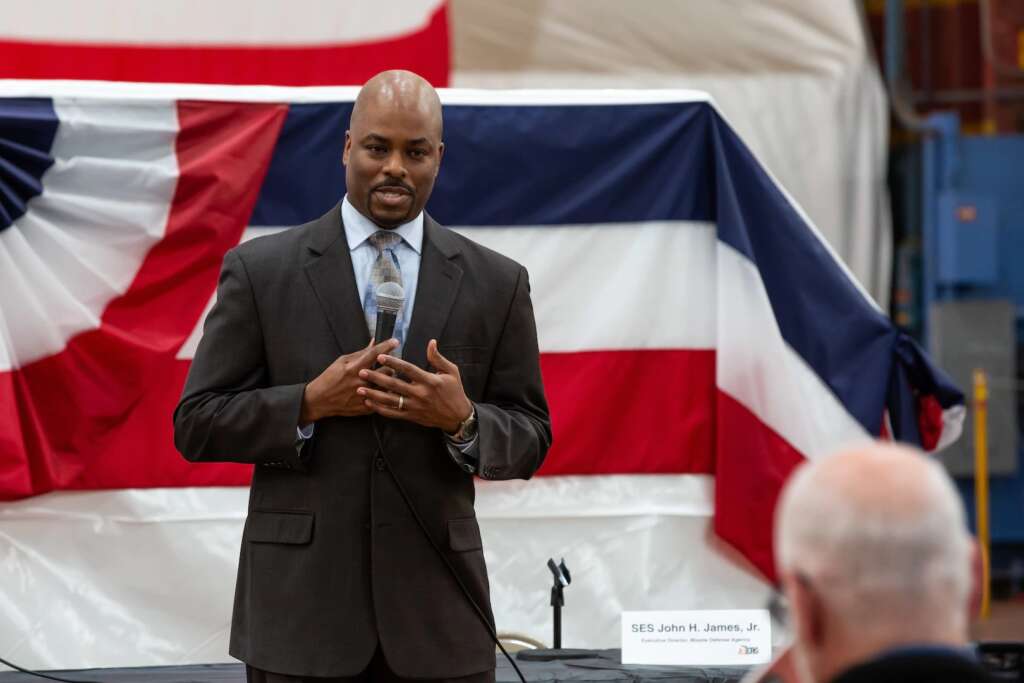Navy Department to increase accountability of primes to meet subcontracting goals
Jimmy Smith, the director of the Office of Small Business programs for the Department of the Navy, said the service awarded more than $17 billion in prime contracts...
The Department of the Navy (DoN) spent more than $17 billion in fiscal 2021 with small business prime contractors. Once again, the DoN met or exceeded all of its small business goals.
Where the Navy Department is still struggling is ensuring small business subcontractors are not being used as bait by large businesses to get contracts and then not receiving their fair share of work.
Jimmy Smith, the director of the Office of Small Business programs for the Department of the Navy, said a new effort across the service will better enforce small business subcontracting plans.

“The Navy executed a Navy audit, service audit on subcontracting on our 10 major buying commands. The Naval Sea Systems Command was the first of those 10 audits. The audit has concluded. We’ve already seen the results of that and now we’re sharing that information across the entire enterprise to go off and correct problems,” Smith said in an interview after he spoke at AFCEA NoVa’s Navy IT day. “We don’t think we’re going to learn anything more from going over the same information in the other audits, so now is the time to get into corrective actions and the steps that we need in order to execute solutions to problems instead of continuing to admire problems.”
Smith said the Navy will continue to audit the nine other buying commands, but will take what it learned from previous audits and continuously evolve the reviews. He said there are some needed changes that emerged from the first audit that cut across the entire service.
“First is reporting back from our industry partners. We have to make that something that’s pretty standard, maybe use a machine learning technology to help contracting officers identify problems that are in contractor performance assessment reporting (CPARs) when it comes to how well our industry partners are doing meeting their own subcontract and goals, that they can communicate it to us,” he said. “We would love to have a system that flashed bright red lights when an industry partner wasn’t living up to the plan in the document that they provide to us about the health of their effort. Right now, it’s all hand-over-hand reading to see if you find that someone is off and then go do the analysis. I think we have to come up with a mechanism that brings the importance level of subcontract and compliance up to a higher level to raise it to the attention that it’s deserved.”
A DoDwide challenge
While it’s important for industry to live up their side of the bargain, agencies, traditionally, haven’t done a good job of holding large firms accountable.
In 2018, for instance, the Defense Department inspector general told the House Small Business Committee that in looking at five contracting commands, it found a consistent challenge in monitoring prime contractors’ compliance with individual subcontracting plans and determining why individual contractors with subcontracting plans did not meet their small business subcontracting goals.
Smith said there are some questions that remain about when that accountability kicks in — during the first year after an award or after all options of the contract?
“There’s great debate going on at that Small Business Administration level on this very topic. We’re waiting for real tangible guidance to come out to kind of drive down that policy,” he said.
The Federal Acquisition Regulations Council tried to answer some of the questions about small business subcontracting that have come up over the years. The FAR Council issued a final rule in August requiring large businesses to make “good faith efforts” to meet subcontracting goals. This final rule implements SBA’s 2019 policy change. SBA’s guidance lists of examples of activities that reflect a failure to make a good faith effort.
The FAR Council estimated that there are 19,596 subcontractors, of which 80% are small firms. Data from the Federal Procurement Data System for fiscal years 2018 through 2020 show 7,656 entities with 30,414 new awards that required subcontracting plans.
Shane McCall, a partner with the law firm Koprince McCall Pottroff LLC, wrote in an August blog post that, “it will be a material breach of a contract or subcontract if a contractor with a subcontracting plan fails to comply in good faith with the requirement to submit reports and cooperate with agencies to determine subcontracting plan compliance.”
The final rule details what entails not making a “good faith effort,” including turning in subcontracting plan reports late, not having a designated employee to monitor the subcontracting plan and not doing market research — such as outreach, industry days and database searches — to identify small business subcontractors.
McCall said large firms should take this change seriously because non-compliance could result in liquidated damages or other legal remedies.
Achieved small business goals for 4 years straight
Smith said the Navy Department realizes that while every vendor and every prime contractor’s situation is different, contracting officers must be clear in what is expected from the large businesses.
“We want to shape requirements into controlling behavior. When we awarded a contract, prime contractors came in with one idea, the government may change requirements over the life of that contract, and that may upset what we thought we were going to do by way of a subcontract. So there’s many reasons why things don’t get followed through,” he said. “But we should be very conscious of input equals output in that regard and understand the effects that they’re causing. So intentional or unintentional, we should understand those effects.”
While the Navy Department is trying to improve the oversight of its subcontracting programs, the service’s small business prime contracts are doing just fine.
Smith said the Navy Department met all of its small business goals for the last four years. But, he added, the Navy Department’s goal aren’t the numbers themselves, but providing the right capability to the warfighter at the best value.
“The result is the work gets spread around to all the right parties to get the work done. It just so happens that we met our goals and objectives at the output,” he said. “But again, nothing bad actually happens for any federal agency that doesn’t meet their goals and requirements. These are goals that you try to strive to achieve. And it’s great when you meet them, but nothing bad happens when you don’t meet them. But at the end of the day, spreading the work around and helping to build the economy keeps America strong. That’s really what this is going after.”
One way the Navy continues to find small businesses that meet their needs is through a steady outreach effort. Smith said the move to virtual events over the last 18 months has really expanded the DoN’s reach.
“The Navy does an annual small business event with the National Defense industrial Association every year out in San Diego. We’ve actually been able to reach more people in the virtual environment rather than the 2,000-to-2,300 that show up in person, we’ve actually been able to reach more people,” he said. “And if I can do it virtually, I can do it more often over the course of a year. We’re reaching people on a virtual platform so regularly now that I almost don’t look forward to going back to doing them in person, but I still do them in person because there’s nothing that surpasses that personal touch that you get. I’d recently did an in person event in Las Vegas, as a part of this was the Native American economic summit that they do every year. From Vegas I actually did a webinar with folks in North Dakota because I couldn’t physically get there in time to do that particular event.”
Copyright © 2025 Federal News Network. All rights reserved. This website is not intended for users located within the European Economic Area.
Jason Miller is executive editor of Federal News Network and directs news coverage on the people, policy and programs of the federal government.
Follow @jmillerWFED






